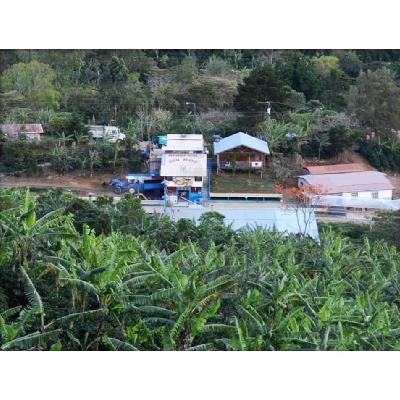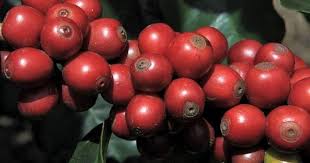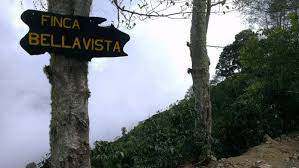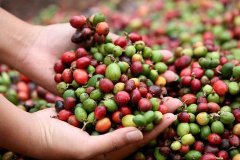Introduction of Tangmeo Manor in Costa Rica description of coffee flavor treated by Tang Meo honey

For professional baristas, please follow the coffee workshop (Wechat official account cafe_style)
Determined to be a leader in Costa Rican coffee, the Tang-Mayo processing plant has a history of 15 years, but it is actually a young processing plant-the family cooperative was founded in 1994, but did not set up its own processing plant until 2005. Located about five kilometers north of Tarazu-San Marcos town, the processing plant is responsible for the research and development of processing technology and the implementation of postharvest treatment for the ten coffee estates joined; as these estates are distributed on a hillside of 1500 to 1950 meters above sea level, all the coffees produced by Don Mayo are of SHB grade.
Traditionally, Costa Rica prides itself on its washed coffee-picking ripe red-purple berries by hand and tightly controlling the soaking and fermentation process. Not much and not a lot of fermentation makes the coffee a perfect balance between clarity and complexity; even if Costa Rican beans are the best washed beans in the world today, I believe many people will agree.

In recent years, however, this tradition is no longer dominant-the new "dry" treatment has become a trend, and micro-processing plants have been set up one after another. Because the water consumption is only 5% of that of traditional washing plants, and there is no need for huge sinks and exposure fields-these micro-treatment plants can be far away from the river bank, and the investment required is relatively small, making it affordable for many independent estates or small cooperatives. More importantly, with the new treatment method and the courageous manor owner, a kind of "honey-treated coffee" with low acidity, high complexity and rich sweet flavor has become the target of competition in the coffee industry in recent years. In recent years, the best of them have shone brilliantly in major competitions, which have greatly enhanced the international reputation of the estates-for example, Brumas, Herbazu, Helsar, Las Lajas, Don Mayo, Montes de Oro …

Because the characteristics of honey-treated coffee depend to a high extent on the setting of the pulp scraper-the more pulp you retain, the more obvious the characteristics of honey treatment. Of course, it takes a bit of risk to produce the most honey-treated coffee, because the more pulp you retain, the higher the risk of overfermentation. It may be the microclimatic conditions (sunshine / rainfall probability / air humidity) where the treatment plant is located. ), or the skill of the processor, or it may be purely the preference of the processor. So even coffee, also known as "Honey Coffee", actually has varying degrees of honey-treated features.
The flavor of this batch of beans belongs to the moderately high honey treatment: low acidity, rich sweet aroma, high thickness and complexity; compared with the existing Herbashi and Jinshan treatment plants, the honey treatment features are relatively obvious, and similar to Lajas, but still significantly lower than Brumas. You can obviously feel this when you have a single product. I believe that the addition of espresso to espresso will bring a lot of unique sweetness of honey treatment.
Product name: Don Mayo Honey Tang Meiomi treatment (also translated as "Tangmeo Manor")
Producer: Beneficio Don Mayo Tang Meo processing Plant
Producing area: Tarazhu (Tarrazu)
Soil: primary laterite (Lateritic origin)
Product type: Caturra
Production season: December 2008 to March 2009
Treatment method: honey treatment method
Other certifications: none
Official website: www.cafedonmayo.com
Important Notice :
前街咖啡 FrontStreet Coffee has moved to new addredd:
FrontStreet Coffee Address: 315,Donghua East Road,GuangZhou
Tel:020 38364473
- Prev

"Napoleon Coffee" St. Helena Coffee beans expensive St. Helena variety Flavor Taste
St. Helena coffee varieties fluctuate greatly: the island coffee variety belongs to Yemen round bourbon, commonly known as green top bourbon, not the variant pointed bourbon, nor Yemen iron bicar. St. Helena coffee varieties are not stable, fluctuating greatly from year to year. St. Helena in good years has obvious citrus fragrance, sweet feeling, similar to Ethiopia's Yega Sherfie, but fruit flavor is low.
- Next

Introduction to the cultivation of bluebells manor in El Salvador the characteristics of coffee in the Santa Ana volcanic area of El Salvador
The exchange of professional baristas please follow the coffee workshop (Wechat official account cafe_style). The bluebell manor in El Salvador CoE Victory Coffee beans is one of the most amazing beans I have ever drunk and one of the most amazing beans except Geishia Geisha, and I can't forget her. And because of the beans from this bluebell manor, I am blindly convinced that the beans in El Salvador are very good.
Related
- Detailed explanation of Jadeite planting Land in Panamanian Jadeite Manor introduction to the grading system of Jadeite competitive bidding, Red bid, Green bid and Rose Summer
- Story of Coffee planting in Brenka region of Costa Rica Stonehenge Manor anaerobic heavy honey treatment of flavor mouth
- What's on the barrel of Blue Mountain Coffee beans?
- Can American coffee also pull flowers? How to use hot American style to pull out a good-looking pattern?
- Can you make a cold extract with coffee beans? What is the right proportion for cold-extracted coffee formula?
- Indonesian PWN Gold Mandrine Coffee Origin Features Flavor How to Chong? Mandolin coffee is American.
- A brief introduction to the flavor characteristics of Brazilian yellow bourbon coffee beans
- What is the effect of different water quality on the flavor of cold-extracted coffee? What kind of water is best for brewing coffee?
- Why do you think of Rose Summer whenever you mention Panamanian coffee?
- Introduction to the characteristics of authentic blue mountain coffee bean producing areas? What is the CIB Coffee Authority in Jamaica?

